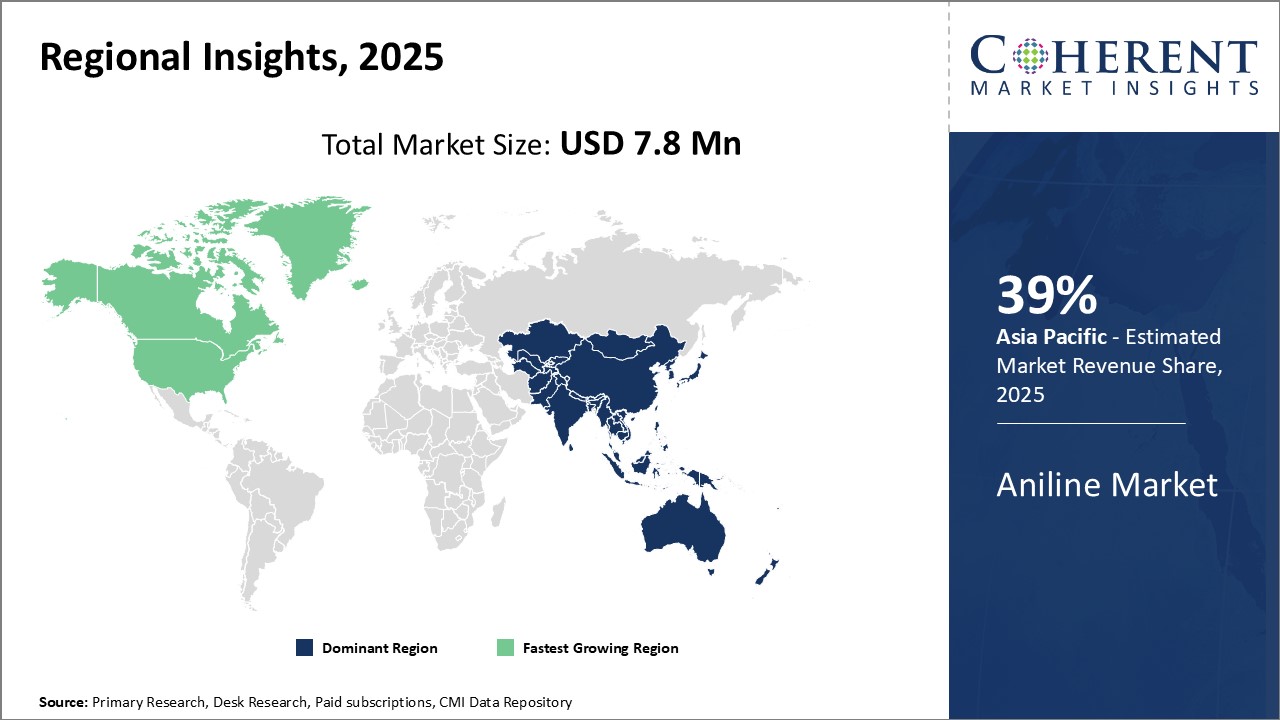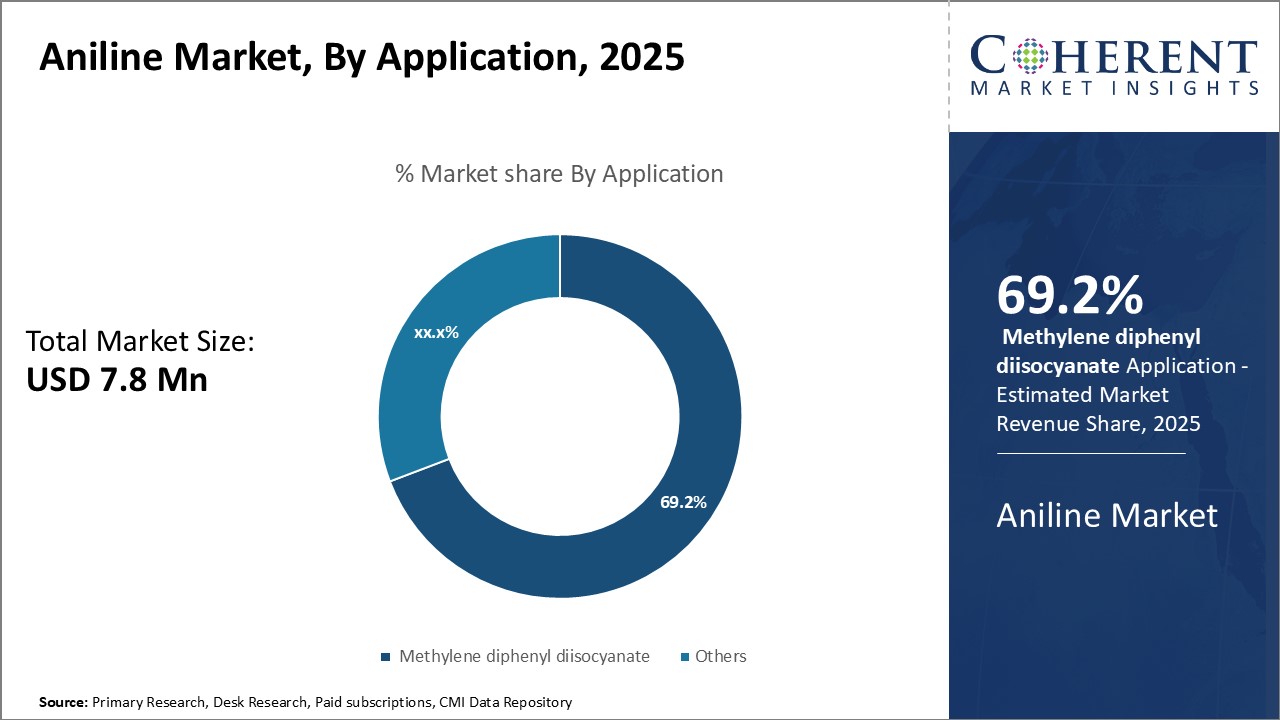The Aniline Market size is valued at US$ 7.8 Mn Tons in 2025 and is expected to reach US$ 11.4 Mn Tons by 2032, growing at a compound annual growth rate (CAGR) of 5.6% from 2025 to 2032.
Aniline is an organic chemical compound that consists of a phenyl group attached to an amino group. It is majorly used in the production of the polyurethane and various chemical products.
Market Regional Insights:
Figure 1. Aniline Market Share (%), By Region, 2025

To learn more about this report, Download Free Sample
Analyst’s Views:
The market is expected to witness steady growth over the next five years. One of the main drivers for the market will be increasing demand from the Methylene diphenyl diisocyanate MDI and polyurethane sector. As construction activity picks up globally post pandemic, MDI and polyurethane demand will rise thereby benefiting aniline producers. Further, automotive industry recovery especially in Europe and North America will boost Methylene diphenyl diisocyanate MDI demand. Asia Pacific region especially China and India will remain the dominant and fastest growing markets owing to rising chemical industry capacities. However, environmental regulations around aniline emissions can pose a challenge. Strict compliance to reduction in greenhouse gas emissions and water pollution may increase producers' costs, thus impacting profitability. Substitutes like toluene may also gain prominence. Volatility in crude oil prices is another factor which the industry needs to closely monitor and hedge. The market may witness some consolidation as large market players look to improve efficiencies and economies of scale. On the positive side, increased R&D and focus on green aniline production technologies can help mitigate environmental risks over time. Further, emerging applications in agricultural chemicals and pharmaceuticals industries open new doors of opportunities.
Market Drivers:
Surging product application in production of MDI: The market has been witnessing significant growth driven by surging product application in the production of various downstream chemicals and materials. Aniline acts as an important precursor in the manufacturing of methylene diphenyl diisocyanate (MDI), which finds widespread end-use in polyurethane foam production for applications such as insulation panels in construction and furnishing, packaging, automotive, and others.
MDI based polyurethane foams have high demand on account of their outstanding thermal insulation and mechanical strength properties. Global construction industry has witnessed a resurgence with renovation and new building projects rising steadily post pandemic. In 2030, according to data provided by the global construction report by Global Construction Perspectives and Oxford Economics, the worldwide construction output is projected to grow by 85% to reach US$15.5 trillion by 2030. This burgeoning construction activity is expected to heavily drive the consumption of insulation panels and other polyurethane products incorporating MDI.
Rising usage in dyes and pigments: Global aniline market is experiencing significant growth driven by the rising usage of aniline in dyes and pigments production. Aniline plays a crucial role in the manufacturing of various aesthetic and functional dyes that are increasingly used across many end use industries like textiles, paints & coatings, pharmaceuticals, and others.
Over the past few years, there has been a steady rise in demand for different types of dyes from the textile industry with rapid growth of apparel and clothing market globally. According to data provided by the World Trade Statistical Review by WTO, in 2022, world textile and clothing exports grew by 13.5% to US$816 billion in 2021 as compared to the previous year, showing strong signs of post pandemic recovery in the sector. This has directly contributed to higher consumption of dyes and consequently aniline, which is the primary feedstock that is used widely for producing different classes of dyes like acid dyes, as dyes, sulfur dyes, and others.
Increasing application in rubber chemicals: The application of rubber chemicals and derivatives that are made from aniline is witnessing strong growth globally. Aniline is a key feedstock that is used in the production of MDI(Methylene diphenyl diisocyanate) and TDI(Toluene diisocyanate), which are important rubber chemicals widely that are used in the manufacturing of various rubber products such as automobile tires, mechanical rubber goods, footwear and various other industrial rubber applications.
With the steady growth in the automobile industry and rising vehicle production worldwide, the demand for high-quality automobile tires has witnessed a significant rise over the past few years. According to data provided by the European Automobile Manufacturers Association, automobile production in Europe increased by over 3.5% in 2021 as compared to the previous year. Growing preference of consumers towards vehicles with larger wheel sizes and versatile tires has further elevated the demand for tire chemicals including MDI and TDI made from aniline. Similarly, the statistics provided by the Automotive News Data Center, shows that, U.S. light vehicle sales grew by over 3% in 2021 from 2020 levels. This rising vehicle demand globally has certainly created lasting demand pull for rubber chemicals and increased the need for aniline as a key component.
Market Opportunities:
Innovation of new aniline derivative products: Aniline derivatives like polyaniline have significant potential for future innovations in the market. These innovative materials can be engineered to have conducting and insulating phases, thereby allowing for applications across multiple industries. For example, these may support advancements in bioelectronics for health care. Polyaniline and its derivatives are biocompatible and capable of interfacing cellular pathways through chemical and electrical communications at neural interfaces. This could enable new platforms for diagnosing and treating neurological disorders.
Another major opportunity lies in energy storage and conversion materials for more sustainable technologies. Polyaniline and other aniline polymers are being studied extensively for applications like flexible batteries, super capacitors, and biosensors due to properties like excellent electrical conductivity and good environmental stability. According to the International Renewable Energy Agency (IRENA), global installed renewable energy capacity is estimated to grow by over 60% between 2020 and 2023. As more countries prioritize in transitioning to renewable sources like solar and wind, which require efficient storage solutions, innovative aniline materials could experience rising demand for applications that support this energy transition.
Investment in research and development: Investment in research and development (R&D) presents a promising opportunity for growth in the market. Aniline is a widely used intermediate in the production of numerous industrial chemicals like polyurethanes, synthetic fibers, pesticides and rubber processing chemicals. With advancements in technology and changing customer preferences, there is potential to develop novel applications and derivatives of aniline that address unmet needs. Focused R&D can help diversify end use industries and tap into new application areas. Sustained investment in developing green production techniques for aniline would also drive the market upwards. At present, traditional aniline synthesis methods rely on non-renewable feed stocks and release harmful byproducts. With growing environmental consciousness, companies face increasing pressure to adopt sustainable practices. Research to derive aniline through bio-based or other clean methods can make the process more eco-friendly. This aligns well with the global transition towards a low-carbon economy. Successful innovations here may receive support in the form of subsidies or policy incentives from governments and inter-governmental bodies.
Aniline Market Report Coverage
| Report Coverage | Details | ||
|---|---|---|---|
| Base Year: | 2024 | Market Size in 2025: | USD 7.8 Mn |
| Historical Data for: | 2020 To 2024 | Forecast Period: | 2025 To 2032 |
| Forecast Period 2025 to 2032 CAGR: | 5.6% | 2032 Value Projection: | USD 11.4 Mn |
| Geographies covered: |
|
||
| Segments covered: |
|
||
| Companies covered: |
BASF SE, Bayer Material Science LLC, I du Pont de Nemours and Company, Huntsman Corporation, Jilin Connell Chemical Industry Co. Ltd., SP Chemicals Holdings, Ltd., Sumitomo Chemical Company, and The Dow Chemical Company. |
||
| Growth Drivers: |
|
||
| Restraints & Challenges: |
|
||
Uncover macros and micros vetted on 75+ parameters: Get instant access to report
Market Trends:
Market Restraints:
Figure 2. Aniline Market Share (%), By Application, 2025

To learn more about this report, Download Free Sample
Recent Developments:
Top Companies in the Global Aniline Market
Definition: Aniline is an organic compound with the chemical formula C6H5NH2. It is a colorless, oily, and slightly water-soluble liquid that is poisonous and has a pungent odor. Aniline is a significant commodity chemical that is used in the manufacture of dyes, plastics, pharmaceuticals, and explosives. It is also a versatile starting material for fine chemical synthesis, and its main use is in the production of precursors to polyurethane, dyes, and other industrial chemicals. Aniline is obtained by the reduction of nitrobenzene and is used chiefly in organic synthesis.
Share
Share
About Author
Vidyesh Swar is a seasoned Consultant with a diverse background in market research and business consulting. With over 6 years of experience, Vidyesh has established a strong reputation for his proficiency in market estimations, supplier landscape analysis, and market share assessments for tailored research solution. Using his deep industry knowledge and analytical skills, he provides valuable insights and strategic recommendations, enabling clients to make informed decisions and navigate complex business landscapes.
Missing comfort of reading report in your local language? Find your preferred language :
Transform your Strategy with Exclusive Trending Reports :
Frequently Asked Questions
Select a License Type
Joining thousands of companies around the world committed to making the Excellent Business Solutions.
View All Our Clients